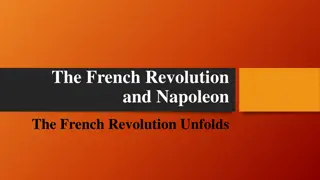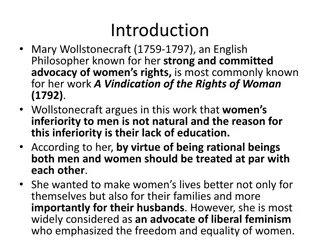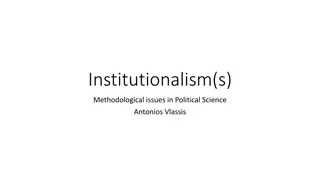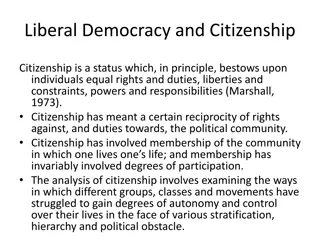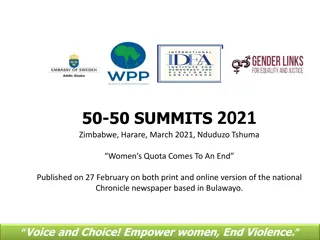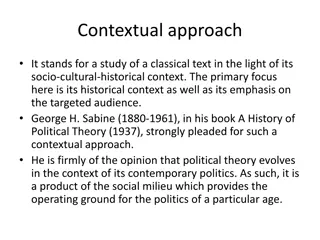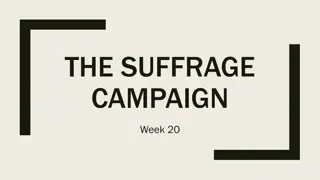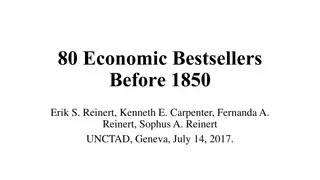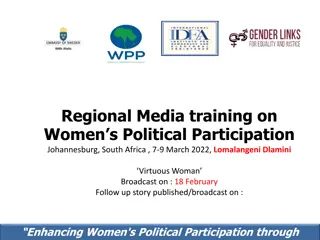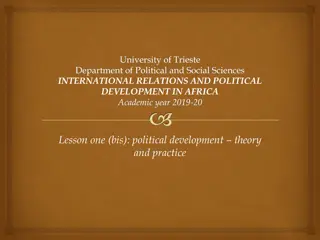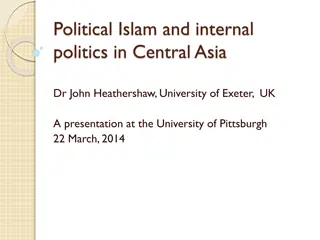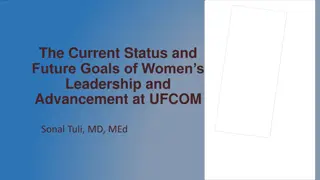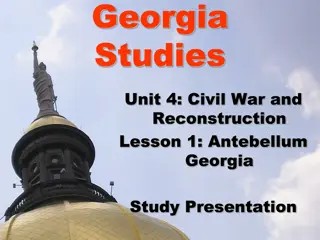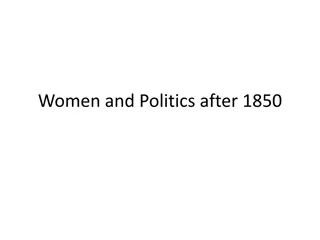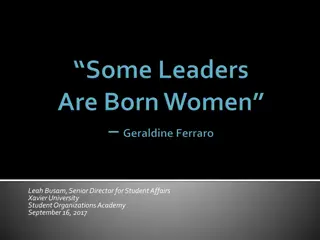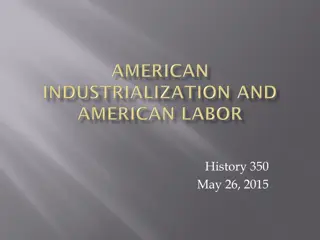Women and Political Radicalism 1790-1850: A Historical Perspective
Women's involvement in political radicalism during the late 18th and early 19th centuries is explored, highlighting their roles in various movements and the challenges they faced. From the lack of voting rights to active participation in radical groups, women made significant contributions despite societal constraints. The narrative delves into the Zetetic Movement, Peterloo Massacre, and the struggles faced by women like Mary Anne Carlile and Susannah Wright in advocating for political and social change.
Download Presentation

Please find below an Image/Link to download the presentation.
The content on the website is provided AS IS for your information and personal use only. It may not be sold, licensed, or shared on other websites without obtaining consent from the author. Download presentation by click this link. If you encounter any issues during the download, it is possible that the publisher has removed the file from their server.
E N D
Presentation Transcript
Women and Political Radicalism 1790-1850
Eighteenth Century Politics the preserve of the elite. Most middle class men received vote in 1832. Women had no right to vote or sit as MPs. Indirect influence through canvassing and networking, e.g. Georgian Cavendish, Duchess of Devonshire.
Nineteenth Century Change in political culture. Demand for politics to represent the interests of the people not just the elite. Female groups attached to mainstream parties e.g. Primrose League. Growth of radical protest groups in which women played a complex role. Middle class radicalism more sympathetic to women than working class groups.
Focus: Role of women in radical political groups. Zetetic Owenites Chartists
Zetetic Movement Zetetic : proceeding by inquiry, a search, investigation or seeker. Centred on London publisher, Richard Carlile s radical free thought movement 1815-32. Republicanism: publications attacked church and Govt. 1819. Publications attracted 9 charges of blasphemous or seditious libel. Sentenced to 3 years in gaol, 1,500 fine and massive good behaviour sureties.
Peterloo Massacre Key Speaker: Manchester, 1819. Soldiers charged crowd of 80,000 people. Demand political representation for north. 15 killed and 400 700 injured. Led to tighter restrictions on protest.
Women in the Zetetic Movement Women rallied to the cause. (Ian McCalman) While in Prison, Carlile s wife, though 8 months pregnant, worked in his shop and produced free thought publications. Early in 1821 she was jailed with her baby for 2 years for seditious libel. Mary Anne Carlile (sister), carried on the work. Charged but acquitted which was seen as a stunning moral victory. Susannah Wright volunteered to attend the business at all risk sold Carlile s Address to the Reformers of Great Britain Trial a propagandising, publicity drive, 18month sentence made her a heroine. Susannah s letters to the Republican denounced a wide range of sexual iniquities In response Carlile produced an explanation of why education was the key to the complete emancipation of women.
Sexual Freedom After his release Carlile became preoccupied with the issue of birth control and its sexual ramifications i.e. free love. Published 1st popular contraception manual: Everywoman s Book or what is love? Challenged the sexual codes that dominated society. Left his wife and entered a new relationship with Eliza Sharples a chief lecturer at his freethinking institute. Zetetic movement made early link between feminist and sexual ideology but also illustrated limitations of women and feminism.
Owenism Working-class movement which also politicised sex and marriage. Established by Robert Owen factory owner who hated capitalism! Aim: co-operation with no class or gender hierarchy. 1800-29 he ran his New Lanark Mills as a model factory village a beacon of the new social order he desired. Founded 16 communities in USA and 10 in UK. In 1820s he helped to establish the co-operative retailing movement.
Owenism and Feminism Suppression of women necessary to capitalist society so need to end capitalism. Critical of marriage as it maintained patriarchal power over women. Owen, Lectures on the Marriage of the Priesthood in the Old Immoral World (1835) identified marriage as distorting and degrading natural sexual instincts and relationships. William Thompson, Appeal of One half of the human race: women treated as slaves. Liberation of men and women depends upon a liberation of passions. Transformation of isolated and anti-social households into wider bonds of membership of a community. In such communities all domestic labour and childcare would be communally undertaken world peace and harmony!
Role of women in Owenism Women gave public talks, attended lectures, contributed articles and participated in the new communities. Women expected to play equal role in governing movement but in practice few female officials. Gender divisions maintained e.g. women in communities still expected to do housework while working class men disliked idea of wage earning women. Very few members supported Owen s view of sex and marriage e.g. Margaret Chappelsmith argued against the false ceremony and system of marriage but recognised the necessity of permanent unions based on mutual respect within a communitarian framework. Female discontent brought end to movement: when male leader of community, Manea Fen, declared intention to put sexual freedom into practice the community soon collapsed.
Chartism Most extensive working class movement of the first half of the 19th century 1000s of supporters. Provoked by Great Reform Act (1832) m. class men received vote. Goal: their People s Charter (1838) to be made law. 6 aims: universal male suffrage, annual parliaments, equal electoral constituencies, secret ballot, the payment of MPs, and the absence of property qualifications for office.
Chartism and Women Leaders made a particular point of appealing to women as well as to men: Let every man, woman and child sign the petition Go on, Go on virtuous women! we re engaged in the cause of justice which is the cause of God. Sign the petition! William Lovett: 1st draft of People s Charter made provision for women s suffrage but was omitted from final version from fear of retarding the progress of suffrage for men. Role of women often overlooked by historians. Early chartist historians played down role of women as wanted to present it as serious political organisation. Feminist historians discounted Chartism because not specifically feminist. good men!
Inclusion of women pragmatism not ideology. Anna Clark has noted that language of Chartism was highly gendered. Women more concerned with social welfare issues such as the operation of the Poor Law, temperance, the low level of wages and the threat of the press gang. Chartism had to mobilise the power of numbers as lacked political power and had to appeal to women as well as men. They organised female powerloom weavers, housewives and teachers alongside male workers inviting them all to mass meetings. But no principle of gender equality. Chartists tried to create a new ideal of working class manhood.
Chartism and Domesticity Family was an arena of struggle in which a private, economically oppressed family was posed against the notion of a family of the people. Barbara Taylor argued that Chartists were concerned with dislocation of family relations. She argues that compared to the Owenites, Chartist women s desire for a traditional home centred life. This helped relegate feminist concerns below that of class for many decades. Jutta Schwarzkopf supported this arguing that despite their avowed radicalism they stopped short of questioning the belief in women s home-centredness Thompson argues that working class women disappear from public politics from the 1840s not to reappear until the 1880s
Conclusion Two opposing views One: Failure of radical groups led to withdrawal of women s rights for public domain. Evidence to support this view is the lack of radical political activity after the 1840s, the passage of protective legislation which regulated women in the workforce and the formalisation of politics which was rooted in a male culture of clubs and pubs. Two: women were able to use the dominant discourse and subvert it for their own ends the development of militant domesticity as Clark terms it. This drawing the political sphere into the realm of the home where women were dominant has parallels in the political aspects of middle class philanthropy and thus can be seen as a way in which women participated in politics on their own terms
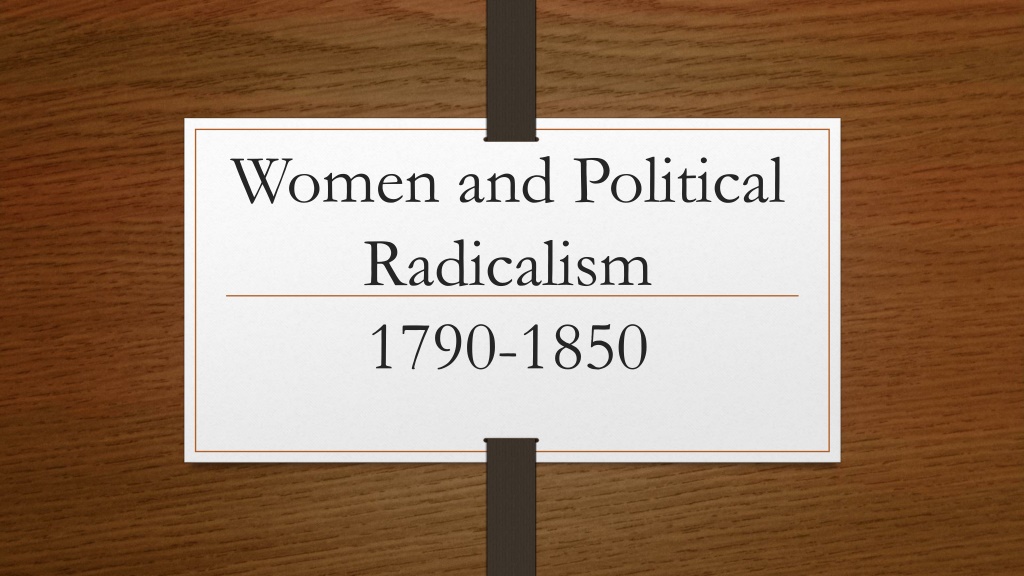
 undefined
undefined





